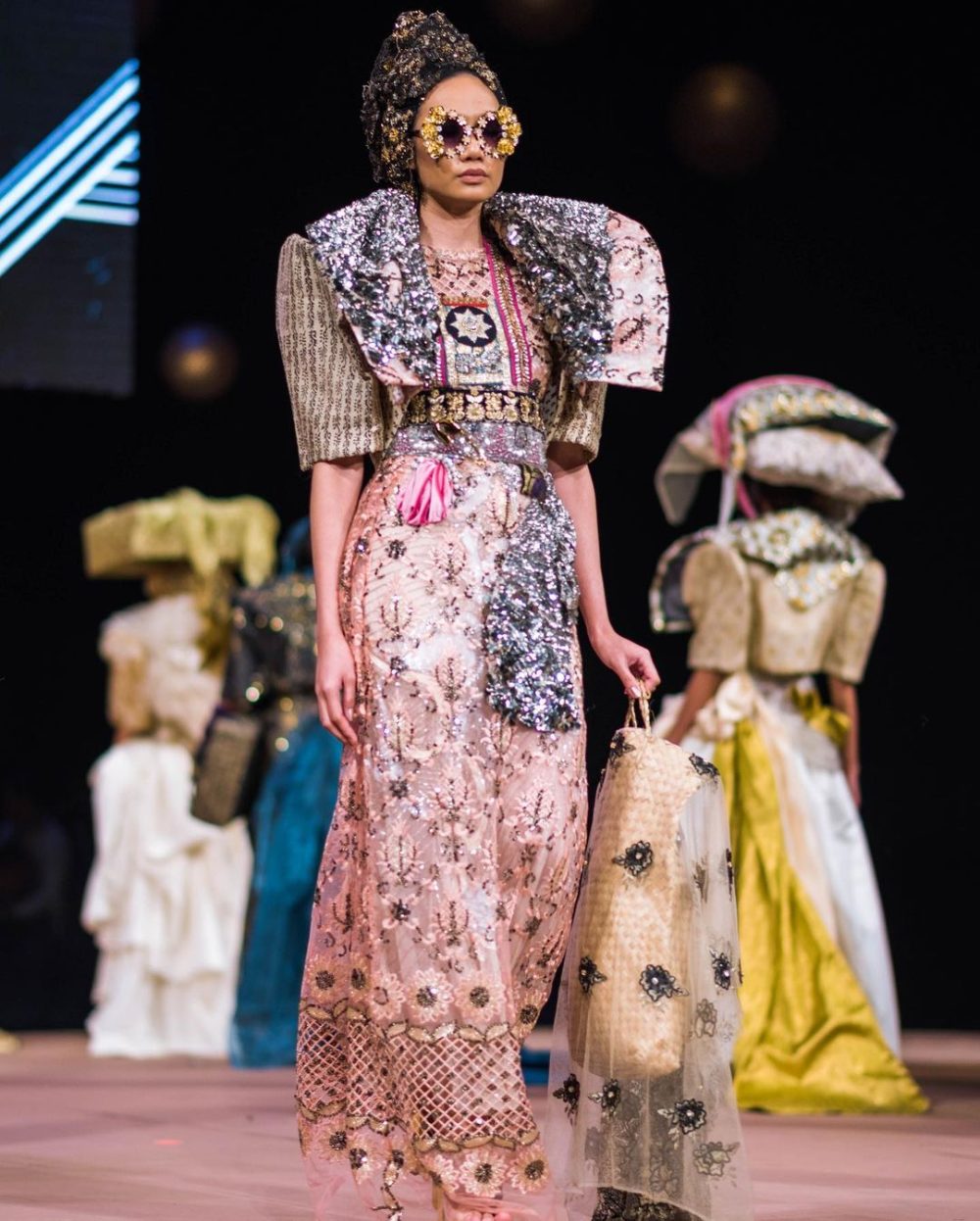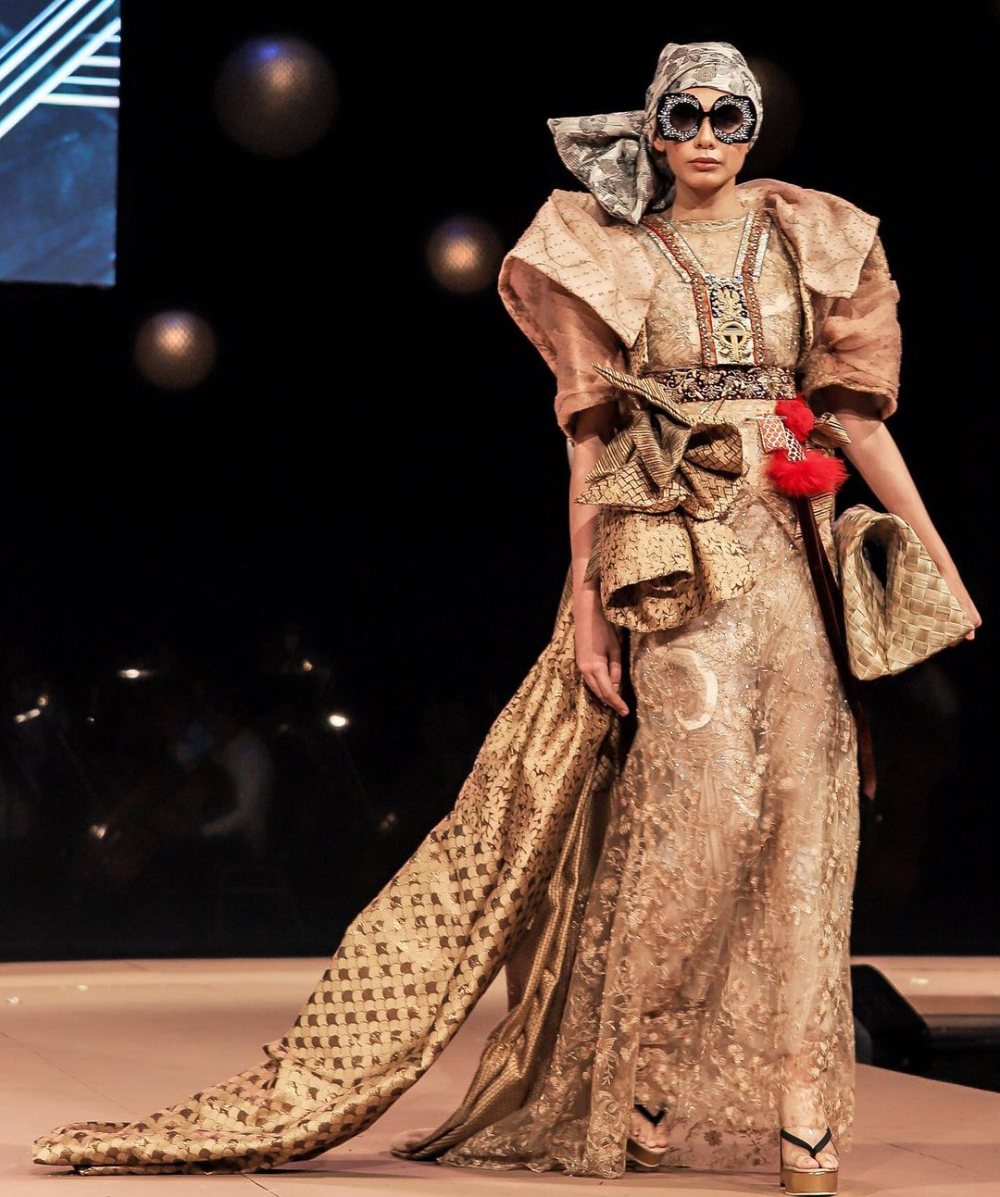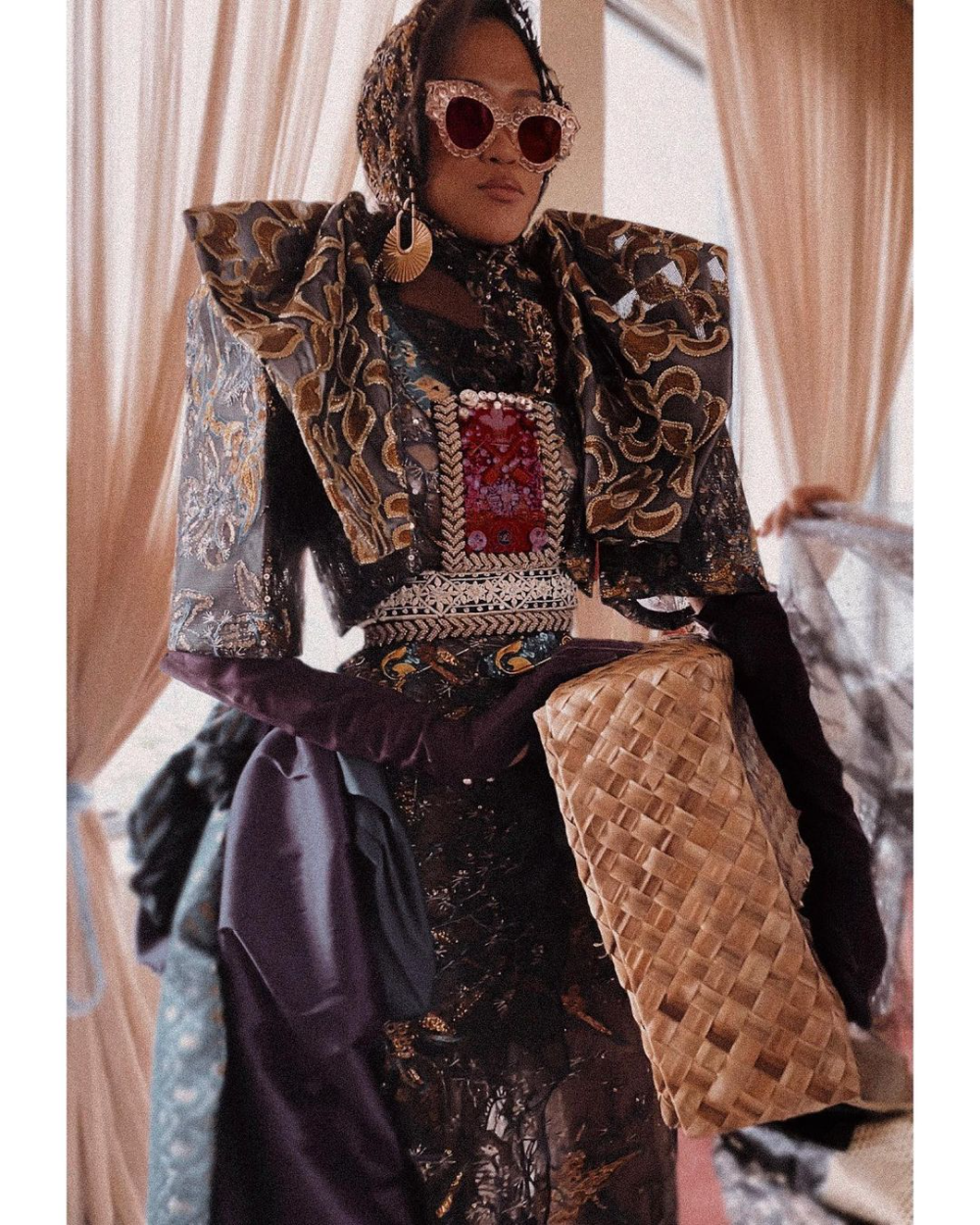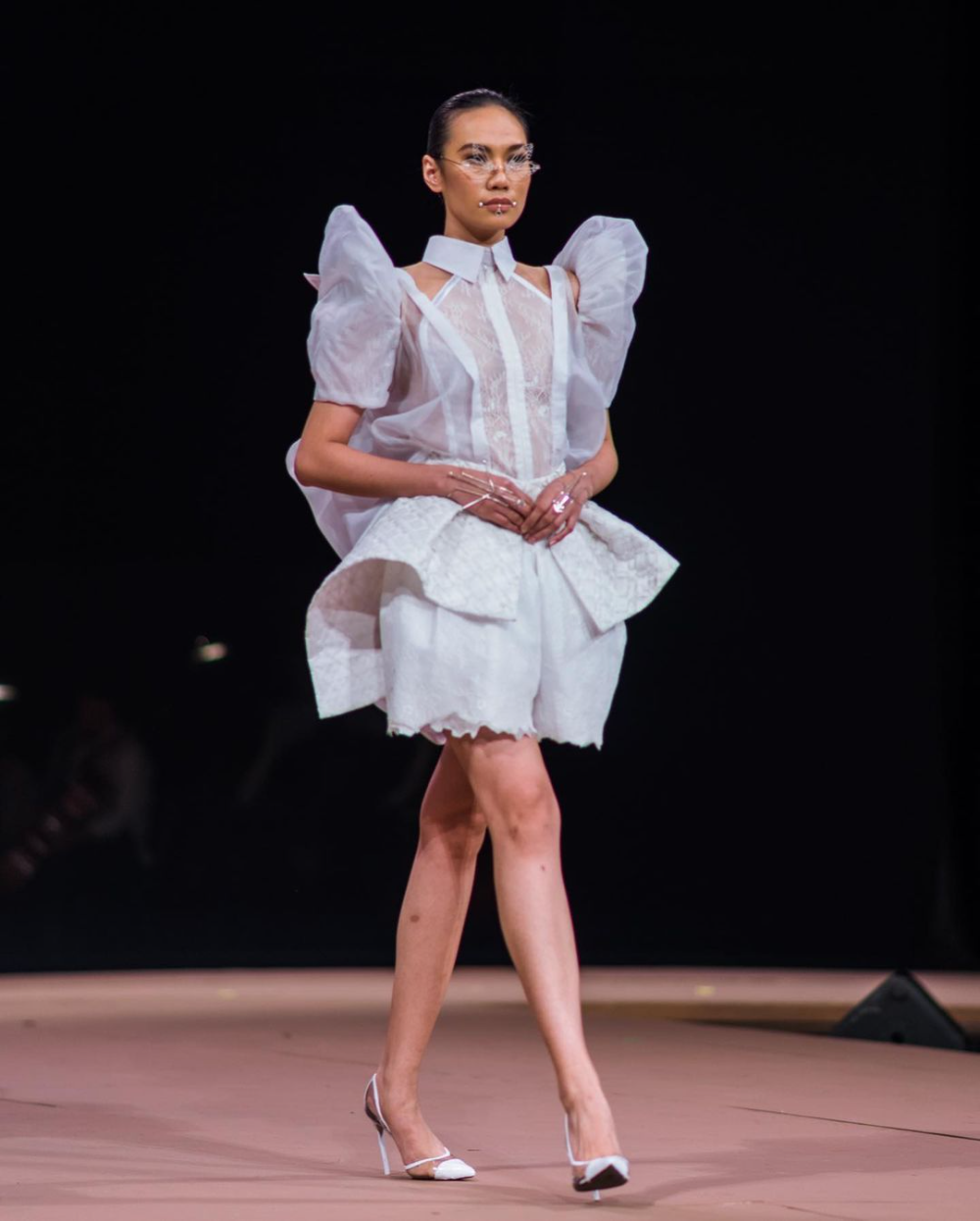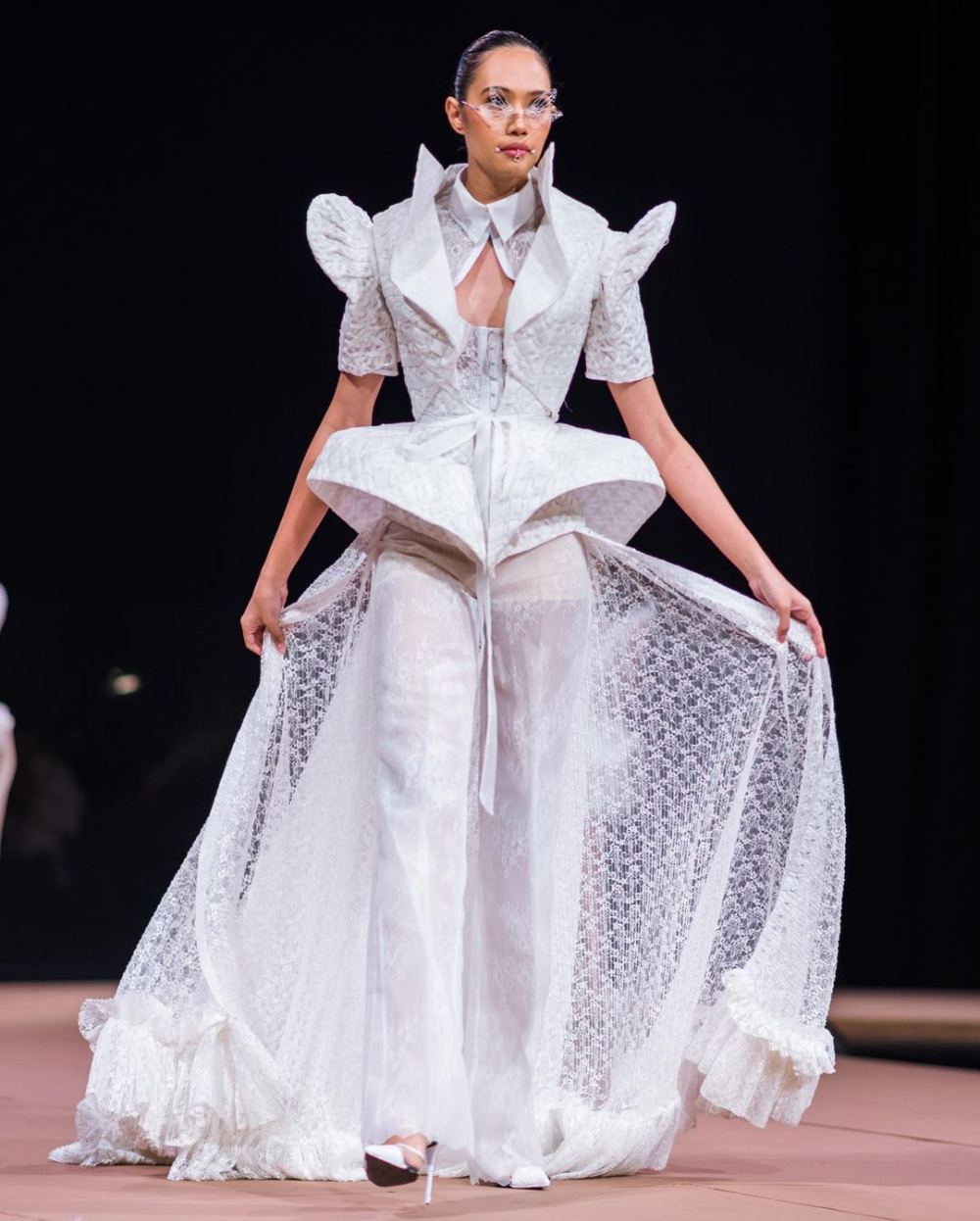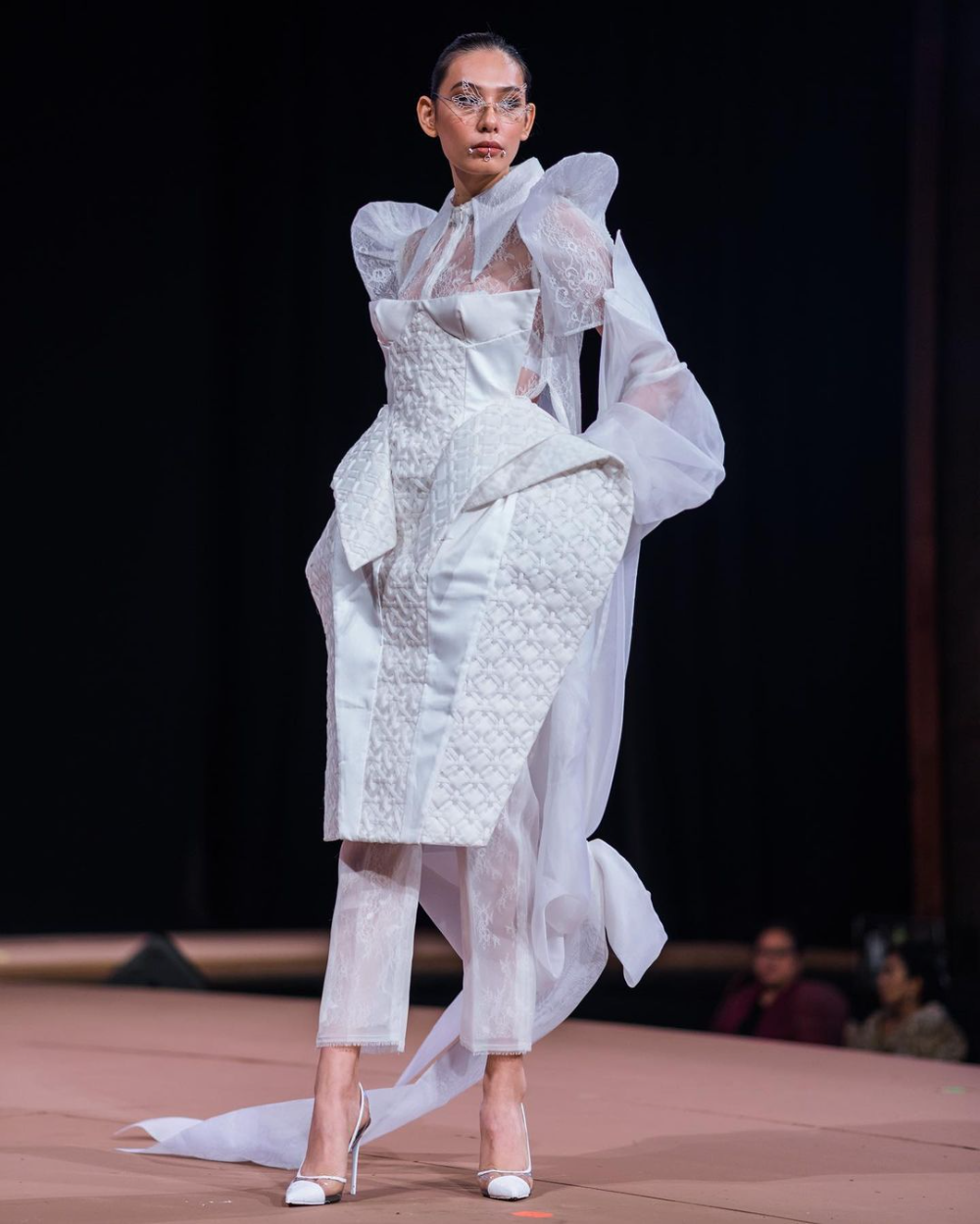Redefining Filipiniana at Ternocon 2020
Hannah Adrias' Ternocon 2020-winning design on model Hannah Locsin. Photo: Miguel Alomajan for INQ Lifestyle
For one night, celebrities and models in designer ternos descend upon the Cultural Center of the Philippines to honor the country’s national dress. The Ternocon, a Filipino Met Gala of sorts, is part gala, part theatre and part fashion design competition. Founded by Fashionable Filipinas author Gino Gonzales and Ben Chan, chairman of major fashion chain Bench, their aim is to revive interest in the terno amongst locals and the Filipino fashion industry, as well as present the future designers carrying on the tradition. Ultimately, Gonzales and Chan want Filipinos to proudly wear the terno like the Japanese with the kimono or Koreans with the hanbok.
The terno is the national dress of the Philippines, distinguished by its peaked butterfly sleeves. Like the Filipino people and the country’s history, the terno is the result of centuries of transformations, adaptations, and combinations. Its only constant is the butterfly sleeves – stiff flattened sleeves, as high as 15-17 inches, rounded into a complex construction of equilateral pleats. The terno is an adaptation from the Traje de Mestiza, which was a Spanish colonized adaptation of the Baro’t Saya. Since the 1940s, the terno is recognized as any western-style dress or separates (top and bottoms) with butterfly sleeves.
The Ternocon competition encompasses three groups hailing from three major areas of the Philippines. Each group is assigned an established Filipino fashion designer as their mentor. For seven months, their mentor teaches them how to properly construct a terno, the butterfly sleeves, and conceptualize a three-piece collection. It’s a unique challenge to create innovative designs that make the terno relevant yet retain its heritage. A committee (from the CCP and Bench) judges the competition based on craftsmanship, wearability, and creativity. A red carpet gala is held leading up to the competition, where Filipino celebrities like Liza Soberano and Lovi Poe show off fashionable ternos by renowned Filipino designers like Inno Sotto and Marlon Tuazon. Interspersed throughout the runway competition are traditional Filipino dance and music acts to further celebrate Filipino pride.
BTS & runway pics from ternocon 2020 - designers (in order): lesley mobo, Jaggy Glarino. images via instagram
To honor the Ternocon’s anniversary, we wanted to reflect on its historic impact on Filipino fashion and culture. Hella Pinay chatted with fashion designers CJ Martin, Renz Reyes, and Ternocon 2020 winner Hannah Adrias about their design philosophies, the Filipino fashion industry, and what the terno means to them.
Hannah Adrias
Gold winner of the Ternocon 2020 competition, Adrias studied fashion design, dressmaking, draping, and tailoring from 2012-2017 at the prestigious Slim’s Fashion and Art School in Makati.
Photo by Miguel Alomajan for INQ Lifestyle
Hella Pinay: First off, congratulations on your winning military-inspired terno collection at Ternocon 2020! I loved your concept of a strong empowered Filipina. Were there other inspirations behind your collection?
Hannah Adrias: Thank you! I still can’t believe I won! My inspiration came from menswear pieces. I wanted to make a traditionally feminine garment into something that’s easy to wear, fun and youthful. I wanted to see people wearing ternos casually.
What prompted you to enter the Ternocon 2020 competition?
Hannah Adrias: Ever since attending Slim's [Salvacion Lim Higgins Fashion design school], I have always been fascinated by our culture. At Slim’s, we do ternos for our thesis and learn Salvacion Higgins’ way of making them. Also Sir Mark Higgins, my mentor at Slim's, co-wrote the book Fashionable Filipinas, with Sir Gino Gonzales. They show the evolution of the Philippine national dress, which is what really got me inspired to join the competition.
What was the design process like?
Hannah Adrias: For ten months we studied how to make a terno sleeve. Each group had a mentor and Sir Lesley Mobo was [mine]. He mentored five of us who all had different takes on the terno. For the first week, we had to stay in a hotel and go to CCP every day from 7am until 10pm brainstorming our designs. They [the mentors] would see our collection every month, consult with my mentor via calls and messages and then we do revisions. It was stressful but it was fun because we all became friends. It took me seven months to finish the collection. Even until the day before the Ternocon we were still sewing – finishing accessories, sewing sleeves on the bodice, and basically helping each other out.
What was it like working with Lesley Mobo as your mentor?
Hannah Adrias: I was so honored to be mentored by Sir Lesley Mobo. He helped expand my design thinking even though his design aesthetic is far from mine. I’m a minimalist and I can’t do avant-garde design, so our design aesthetics differed. Our way of designing is so different which was good because it helped broaden my thinking and designing skills. He said when designing think of who you’re designing for. My design aesthetic changed a lot through the workshops.
I read somewhere there was a slight controversy because your terno collection was more casual. Could you explain why that would be a controversy?
Hannah Adrias: I think they’re criticizing me because they want ternos to be formal, but I don’t think that’s the way to go now. Some ternos you can’t sit in and you can’t move, but my take is you can go anywhere wearing them. Ternos used to be worn every day outside, so why can’t we do that now? They should be celebrated and worn more casually like before. I design for myself and what I would want to wear.
Photos by Miguel Alomajan for INQ Lifestyle
When you talk about Filipino fashion you mention you mostly see male and rarely female fashion designers.
Hannah Adrias: Fashion is a male-dominated industry…I’m not surprised by that because of the talent they exude. I started in 2017 and I’m just having more clients now because I won Ternocon. It’s so hard getting a platform on your own because connections are necessary to pursue this industry and actually have a name for yourself.
If the Filipino fashion industry is mostly men, what has the experience been like being one of the only women in the competition?
Hannah Adrias: I was so proud of myself and I was so happy of course. I never imagined that I would win something this big. All the stress and the anxiety I experienced was worth it. It all paid off.
Since winning the competition what have you been up to?
Hannah Adrias: For the first months, I had clients contacting me through Instagram ordering terno pieces. Then COVID came. We [the business] were really affected because as I’m still starting, I don’t have a shop or a sewer and I sew everything myself. Now that it’s COVID era, I decided to make a collection and join Slim’s Studio @slimsstudio (IG) an exclusive marketplace that features specially curated capsule collections of RTW by alumni of Slim’s Fashion & Arts school.
How has your experience at Ternocon 2020 changed how you design, construct or run your business? If so, how?
Hannah Adrias: It changed a lot. I’m a minimalist who uses black or white colors with no embellishments, but now I’m exploring. Since I used the tailoring method for the first time in Ternocon, my designs are more refined. Before, I was doubting myself everyday...now I’m starting to believe that I am good at something.
CJ Martin
Martin is a Ternocon 2020 finalist and founder of his own label CJ MARTIN. He aims to reduce less waste through upcycling fabric and materials through his namesake label.
What prompted you to enter the Ternocon 2020 competition?
CJ Martin: I was feeling a little stuck in my design career that year and Ternocon became a perfect opportunity to try to learn something new and get my work out there. I felt intimidated at first because I don’t have any background experience on constructing ternos/butterfly sleeves but their previous cycle’s mentorship/lecture-workshop series looked very promising.
Photo: Patrick Diokno via Instagram
Could you guide us through what the process of designing for the Ternocon 2020 was like?
CJ Martin: We were provided with a design brief of creating three contemporary ternos which should appeal to the millennial generation. My collection “Balik-Tanaw” is inspired by the landscape of my home province Nueva Vizcaya. I wanted the fit and silhouette to be relaxed and loose to balance the complexity of the fabric manipulation and the stiff look of the butterfly sleeves. After the selection of the finalists, we had to undergo a series of lecture-workshops on historical clothes and the construction of terno/butterfly sleeves. During this time, we were allowed to change our design entries with the strict supervision of our mentors (Inno Sotto, Ivarluski Aseron, Lesley Mobo, Gino Gonzales and Philip Rodriguez). I was able to retain my three original designs but the mentors recommended that I try experimenting with the butterfly sleeves’ sizes. They challenged me to use a combination of vibrant colors so the fabric details and patterns can be seen even from afar. It was my first time to use colors in a collection and I am glad my mentors pushed me to go for it because it made my collection distinct from the other finalists.
What prompted you to centre your brand around sustainability and reducing less waste?
CJ Martin: Back in design school, we had an activity in Design Studio class called rapid prototyping wherein we need to transform an old garment into a new form within a time limit of 30 minutes. I got two jackets from a thrift store and converted them into a cocktail dress and a pair of shorts. My professor was very impressed and it was that experience that sparked the idea of how I want my brand’s business model to operate.
Honestly, I find it uncomfortable calling my brand sustainable because it puts a huge pressure to justify or quantify the level of effort that I am doing. I prefer to break it down into a simpler word like UPCYCLING so people can easily understand my brand’s story and how I add value to my clothes. Coming out of fashion school, I had a lot of excess fabrics from previous projects and my savings was almost gone so I upcycled out of necessity rather than as a conscious decision. This was also the time where I tried joining different fashion competitions because it was the easiest way to showcase my work and get connected with people in the fashion industry. In 2018, I was able to represent our country in the Redress Design Award in Hong Kong. It is one of the largest international fashion competitions around sustainability focusing on design strategies and utilization of textile waste. Though I didn’t win, the experience was enriching and gave me a fresh perspective on how I can utilize upcycling as part of my brand’s core.
In the past few years, sustainability has been a hot buzzword in the fashion industry. How do you feel about the fashion industry becoming more mindful of their production and waste practices?
CJ Martin: I’m very happy that the fashion industry is making more conscious choices right now because it’s about time we realize that raw materials are finite and the products we put out there has a direct impact on the environment and supply chain. Here in the Philippines, we may be limited in technological advancements but we adapt easily and use our creativity to explore solutions to production and textile waste problems.
What changes have you seen in the Filipino fashion industry and what would you like to see changed?
CJ Martin: Nowadays, I noticed that local brands are more rooted in transparency and collaboration with local artisans with the clear intention of elevating artisanal craft to an explored design. I think the Filipino fashion industry is off to a good start when it comes to supporting local but we have to keep the pace if we aim for a substantial change. What I would like to see is for upcoming designers to be given an equal opportunity to showcase their work and hopefully access progressive mentorship programs like the one I had at Ternocon 2020.
Has your experience at Ternocon 2020 changed how you design, construct or run your business? If so, how?
CJ Martin: Yes, definitely. I learned from Ternocon’s lecture-workshops that our ancestors had always been resourceful and self-sufficient when it comes to utilizing textile. They create their own fabrics through the use of handlooms and they maximize the yardage by using fabric manipulations like pleating, tucking, tying or draping. With these new discoveries, I was able to integrate these observations into my design process and shift my brand’s production to creating limited edition or custom-made pieces for now.
Renz Reyes
Finalist of Ternocon 2020 under the tutelage of Lesley Mobo. Prior to Ternocon, Reyes is an established designer and winner of the Bench design awards 2019 who presented his S/S 2019 collection at Amazon Fashion Week Tokyo.
How would you describe your design aesthetic?
Renz Reyes: I design embroideries for a living so surface design dictates my design sensibilities. I think about textiles first and the techniques that I’m going to use. Then I develop the type of embroideries and fabrics and the embroidery dictates what the garment will be. I always go for graphic or visual sensibilities. I like geometric patterns, colour, colour blocking and mixing materials. That’s one of the biggest things for me, is mixing different materials, graphics and prints.
Renz Reyes’ terno collection for Ternocon 2020. Model: Hannah Locsin. Photo: Miguel Alomajan for INQ Lifestyle
Your clothes and fashion illustrations are very graphic! Which artists are you inspired by?
Renz Reyes: Before I was a designer I was a graphic designer so that can be seen in my fashion work. Artist wise I like Art Deco. Erté is one of my biggest inspirations. His fashion illustrations and clothing are the best. M.C. Escher is another artist/illustrator I like. He does the tessellation illusion art. It’s very interesting. I actually used one of his illustrations as a motif in my collection for Amazon Fashion Week Tokyo.
Was this your first time making a terno?
Renz Reyes: This is the first time I made an actual terno. I made a terno in school, but I didn't apply it to my usual work. Not a lot of people wanted ternos made or asked me to make a terno for them. So ternocon really pushed me to go out of my comfort zone and spread the message of the terno. I realized I should’ve made more ternos in the past.
Do you think you’ll make more ternos in the future?
Renz Reyes: Yes, I’m incorporating ternos into my collection but more casual and modern. The Ternocon pieces I made were dressy and opulent, but the styles I want to make now are more casual.
Photo: Miguel Alomajan for INQ Lifestyle
What changes have you seen in the Filipino fashion industry and what would you like to see changed?
Renz Reyes: Ternocon is a big force in the fashion industry. Always after Ternocon there is a big resurgence of the terno from different designers. It’s getting there because designers are making casual ternos. We have a lot of bazaars here and most of them sell casual ternos and apply different Filipino codes into their wares. I think now more than ever designers, not only here but from different countries, are the most exciting when they are leaning into their roots. I think people can relate more to a designer that promotes their culture.
Do you feel you need to balance between being a designer and being a Filipino designer?
Renz Reyes: I think in the beginning I was focused on just being a designer. That’s a great foundation to build a base then the Filipino sensibilities can easily be intertwined. Once I built those skills it was easy to tap into the culture because I am Filipino and have always known Filipino history. Ternocon made me reevaluate what I’m putting out into the world. There are a lot of clothes in the world and there are a lot of people doing the same thing. Both go hand in hand.
How would you describe the Filipino fashion sensibility?
Renz Reyes: Resourcefulness. We’re very resourceful people. We’re not as blessed as other Asian countries as materials are scarce and limited. The designs we come up with, with so much less, is remarkable to me. That’s also why I do embroideries because most of the time we don’t have access to good textiles. I can counter that by making embroideries and textiles because I know this is something that I can make and you can’t buy anywhere else. Every creative can relate to being resourceful because most materials are not available to us or hard to get. Sometimes it works better that way and makes us work harder because everything is not accessible to us. That’s why when we’re put in international spaces we try more because we’re not used to good circumstances or situations. When we are given certain privileges we work really hard.
Photo: Miguel Alomajan for INQ Lifestyle
How has your experience at Ternocon 2020 changed how you design, construct or run your business? If so, how?
Renz Reyes: What it really imparted in me was spreading the message of the terno. Whenever you can incorporate something from our own culture, that’s great. Before ternocon I used to focus on being modern and experimental but Ternocon made me want to be able to showcase obscure parts of our culture to other people. Whatever way I can to share our culture there. That is the greatest thing I got from Ternocon. Sharing our culture to the world.
CAMAY ABRAHAM
INSTAGRAM/TIKTOK: @CAMAYBRAHAM | REFLEKT MAGAZINE
Camay Abraham (she/her) is a Filipino-American journalist and researcher focusing on fashion, tech, beauty, and Asian and Asian American culture. Graduating with a Master’s in Applied Psychology in Fashion from London College of Fashion, she has written for magazines such as Dazed and Preview and been interviewed by Vice and Deutsche Welle Media. Other than aspiring to be the next Asian Carine Roitfeld, she aims to widen Filipino representation in the fashion world - as well as the real world.



